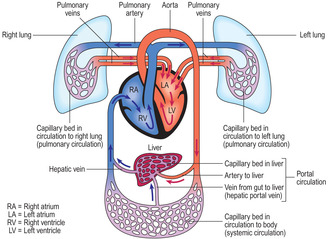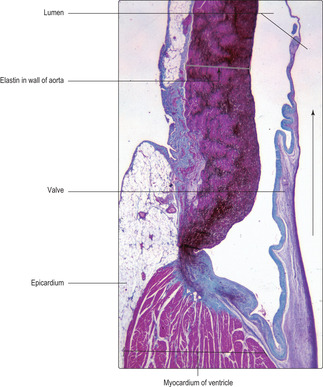The circulatory system consists of the heart and the vessels (tubes) which carry blood or lymph. The heart provides a force that moves blood in the vessels of the cardiovascular system. This part of the circulatory system, the cardiovascular system, ensures blood, carrying oxygen, carbon dioxide, various nutrients, metabolites, hormones and blood cells, is conveyed to, through and from the tissues and organs of the body.
Part of the circulatory system comprises lymphatic vessels which drain some of the extracellular fluid from all regions of the body except the central nervous system. The fluid in lymphatic vessels is known as lymph. It is similar to plasma but does not transport red cells. Lymph is an important means of transporting immune cells, particularly lymphocytes, and lymph vessels carry lymph into and out of lymph nodes (Chapter 8). Lymphatic vessels in the gastrointestinal system also transport lipids absorbed from the gut (Chapter 12). Lymph eventually drains into larger lymph vessels which in turn drain into the blood vessels of the cardiovascular system returning blood to the heart.
Cardiovascular system
The heart is an organ which consists of two muscular pumps that work in synchrony. The two pumps are attached side by side but blood, in adults, does not pass directly between the two sides. The heart develops (in utero) from a single tube which duplicates and twists and only takes on the adult structure and the physical separation of the two sides shortly after birth (see Mitchell B, Sharma R. Embryology: An Illustrated Colour Text. Elsevier: 2004).
Arteries are vessels which carry blood away from the heart whilst vessels carrying blood to the heart are veins (Fig. 10.1). Blood is carried between arteries and veins in small vessels, arterioles, capillaries and venules. Veins deliver deoxygenated blood to the right side of the heart, which pumps it into pulmonary arteries and on to the lungs. In the lungs, the deoxygenated blood passes into capillaries and there it becomes oxygenated. The oxygenated blood returns to the left side of the heart via pulmonary veins. This flow of blood between heart and lungs is known as the pulmonary circulation. Simultaneously, the left side of the heart pumps oxygenated blood into the aorta (the largest artery) from where it is distributed around the whole body. Arterial blood passes through progressively branching and narrowing arterial vessels and eventually through the narrowest vessels, the capillaries. It is from capillaries that oxygen diffuses into surrounding tissues and blood becomes deoxygenated. Capillaries drain into venules and these in turn drain into veins which return the deoxygenated blood to the right side of the heart. This flow of blood around the body is described as the systemic circulation.
In some regions of the body, e.g. the liver (Fig. 10.1), in addition to arterial blood delivering oxygenated blood to capillaries, other blood enters the capillaries from a vein. In the case of the liver, capillaries draining blood from the gut join together and drain into the hepatic portal vein. This portal vein, carrying nutrients absorbed from the gut, supplies blood to capillaries in the liver. This arrangement of vessels involving two sets of capillaries joined by a vein is described as a portal circulation.
Heart
Each side of the heart has two compartments: an atrium and a ventricle (Fig. 10.2). The left atrium receives blood from the lungs in four pulmonary veins and the right atrium receives blood from the rest of the body via the superior and inferior vena cavea. The atria simultaneously contract and pump blood into the paired ventricles. The ventricles then pump the blood into either the systemic circulation (left ventricle) or the pulmonary circulation (right ventricle). Valves between each atrium and its ventricle ensure that blood does not flow back into the atria when the ventricles contract. Other valves prevent back flow of blood from the arteries to the ventricles when the ventricles relax. The contraction of heart muscle is regulated by the autonomic nervous system, though heart muscle cells have an intrinsic ability to contract.
■ Myocardium. The myocardium forms the majority of the wall of the heart: it consists mainly of cardiac muscle cells supported by sparse, fibrous connective tissue. If these muscle cells are sectioned along their length, transverse striations are apparent (Fig. 10.3), reflecting the arrangement of myofilaments in the sarcoplasm of the cells (Chapter 5). Specialised junctions (intercalated discs) attach cells together in series and may be apparent as transverse lines (Fig. 10.3). Although heart muscle cells have an intrinsic ability to contract, sympathetic and parasympathetic nerves are able, respectively, to increase and decrease the rate at which the heart beats. The contraction of cardiac muscle cells is coordinated by specialised cells in several regions of the heart and by communication, via intercalated discs, between individual muscle cells. One specialised cell type, the Purkinje cell, conducts electrical impulses to specific parts of the myocardium so that atria and ventricles contract at appropriate times and blood flows smoothly from atria to ventricles then into the arteries. Purkinje cells are distinguished by their rounded shape (Fig. 10.3) and they have a high content of glycogen.
■ Endocardium. This lines the myocardium. It is made up of a surface layer of squamous epithelial cells, their basement membrane and a sparse layer of connective tissue attaching the endocardium to the myocardium. The epithelial cells of the endocardium are similar to, and continuous with, the endothelial cells lining the blood vessels carrying blood to and from the heart.
■ Epicardium. The epicardium covers the heart and comprises a single layer of squamous epithelial cells, their basement membrane and loose connective tissue which attaches it to the underlying myocardium. Coronary blood vessels supply blood to the heart and lie in the epicardium, in which fat cells may be present in large numbers (Fig. 10.4).
The epicardium is part of a closed sac, the pericardium, which enfolds the heart (Fig. 10.2). It is the inner, visceral layer of the pericardium and is continuous with the outer parietal layer. Each of these two layers is composed of a squamous epithelium, basement membrane and supporting connective tissue and they enclose a potential space, the pericardial cavity. The secretion of minute amounts of fluid into the pericardial cavity by the lining of squamous epithelial cells ensures a relatively friction-free zone against which the heart can move and beat without damaging adjacent cells.
Connective tissue of the heart
Some connective tissue of the heart is condensed and described as a fibrous skeleton. It is a complex arrangement of dense collagen between the atria and ventricles, and around the orifices of the arteries taking blood from the heart (Fig. 10.4). The connective tissue ensures electrical discontinuity between the myocardium of the atria and ventricles except via the specialised conducting tissue; this is essential for the normal rhythm of heart contraction. In addition, the connective tissue anchors the cardiac muscle cells and is the major component of, and anchor for, the valves (Figs 10.3 and 10.4).
Get Clinical Tree app for offline access







